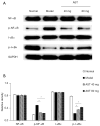Protective effect of astaxanthin on chronic prostatitis/chronic pelvic pain syndrome in rat through modulating NF-κB signaling pathway
- PMID: 39434738
- PMCID: PMC11491227
- DOI: 10.21037/tau-24-190
Protective effect of astaxanthin on chronic prostatitis/chronic pelvic pain syndrome in rat through modulating NF-κB signaling pathway
Abstract
Background: Chronic prostatitis/chronic pelvic pain syndrome (CP/CPPS) is a common male urological disease characterized by chronic pelvic pain and various discomforts. Astaxanthin (AST) has multiple functions, including anti-inflammatory property, but it is unclear whether AST plays a key role in CP/CPPS and how it works. This study aimed to investigate the protective effect of AST on CP/CPPS in rats and the underlying mechanism.
Methods: A CP/CPPS rat model was induced by intraprostatic injection of carrageenan and the blood specimens and prostates were harvested for further research after oral administration of AST for 4 weeks.
Results: Tactile allodynia test showed that AST ameliorated chronic pelvic pain in a dose-depended manner. In addition, histological evaluation indicated that AST alleviated CP/CPPS rat prostate histological inflammation. Meanwhile, AST suppressed the expression of proinflammatory cytokines, including interleukin-1β (IL-1β), IL-6, IL-8, and tumor necrosis factor-α (TNF-α). Besides, AST inhibited the activities of prostaglandin E2 (PGE2) and cyclooxygenase 2 (COX2). Furthermore, AST decreased the activation of the nuclear factor-κB (NF-κB) signaling pathway.
Conclusions: Our study has shown that AST exerts an anti-inflammatory and protective effect against CP/CPPS and the function is mediated at least through the suppression of NF-κB signaling pathway. These results provide evidence of AST as the potential agents for the treatment of CP/CPPS.
Keywords: Astaxanthin (AST); NF-κB signaling pathway; anti-inflammation; chronic pelvic pain syndrome (CPPS); chronic prostatitis (CP).
2024 AME Publishing Company. All rights reserved.
Conflict of interest statement
Conflicts of Interest: All authors have completed the ICMJE uniform disclosure form (available at https://tau.amegroups.com/article/view/10.21037/tau-24-190/coif). The authors have no conflicts of interest to declare.
Figures









Similar articles
-
Astaxanthin alleviates chronic prostatitis/chronic pelvic pain syndrome by increasing colonization of Akkermansia muciniphila in the intestine.Phytomedicine. 2024 Jan;123:155249. doi: 10.1016/j.phymed.2023.155249. Epub 2023 Nov 25. Phytomedicine. 2024. PMID: 38056144
-
The effect of pirfenidone on rat chronic prostatitis/chronic pelvic pain syndrome and its mechanisms.Prostate. 2020 Sep;80(12):917-925. doi: 10.1002/pros.23995. Epub 2020 Jun 22. Prostate. 2020. PMID: 32569423
-
Lycopene attenuates chronic prostatitis/chronic pelvic pain syndrome by inhibiting oxidative stress and inflammation via the interaction of NF-κB, MAPKs, and Nrf2 signaling pathways in rats.Andrology. 2020 May;8(3):747-755. doi: 10.1111/andr.12747. Epub 2020 Jan 7. Andrology. 2020. PMID: 31880092 Free PMC article.
-
Immunological alterations in patients with chronic prostatitis/chronic pelvic pain syndrome and experimental autoimmune prostatitis model: A systematic review and meta-analysis.Cytokine. 2021 May;141:155440. doi: 10.1016/j.cyto.2021.155440. Epub 2021 Feb 4. Cytokine. 2021. PMID: 33550164
-
Chronic Prostatitis and Pelvic Pain Syndrome: Another Autoimmune Disease?Arch Immunol Ther Exp (Warsz). 2021 Sep 14;69(1):24. doi: 10.1007/s00005-021-00628-3. Arch Immunol Ther Exp (Warsz). 2021. PMID: 34523016 Review.
Cited by
-
Astaxanthin mitigates radiation-induced erectile dysfunction: protective effects on corpus cavernosum in a rat model.Int J Impot Res. 2025 Jun 13. doi: 10.1038/s41443-025-01106-6. Online ahead of print. Int J Impot Res. 2025. PMID: 40514409
-
Molecular Mechanisms, Endurance Athlete, and Synergistic Therapeutic Effects of Marine-Derived Antioxidant Astaxanthin Supplementation and Exercise in Cancer, Metabolic Diseases, and Healthy Individuals.Food Sci Nutr. 2025 Jun 27;13(7):e70470. doi: 10.1002/fsn3.70470. eCollection 2025 Jul. Food Sci Nutr. 2025. PMID: 40585493 Free PMC article. Review.
References
LinkOut - more resources
Full Text Sources
Research Materials
Miscellaneous
